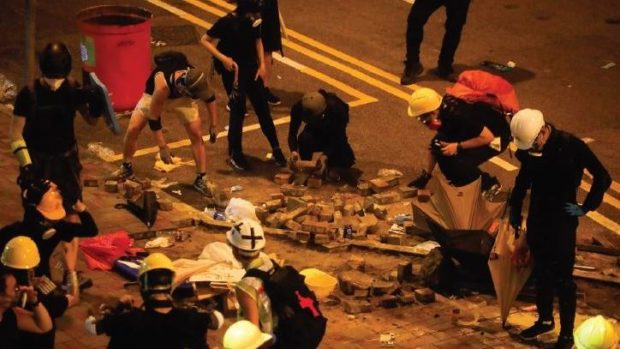Liaison office attack ‘defiance of nation’s sovereignty’—HK gov’t

Masked demonstrators pry bricks from a road near Western Police Station to use them as missiles in battling with the police. China Daily/Asia News Network
HONG KONG — The Hong Kong Special Administrative Region government on Sunday night strongly condemned the hostile attack on and vandalizing of the liaison office — one of the central government’s key institutions in the SAR.
In a statement issued at around 10 pm, the SAR government denounced the radical protesters for their violent behavior, including smirching the national emblem at the Liaison Office of the Central People’s Government in the HKSAR.
Such acts represent a blatant defiance of the nation’s sovereignty, and the SAR government will deal with it seriously in accordance with the law, a government spokesperson said.
The liaison office, as one of the central government institutions in the city, has constitutional functions, the spokesperson said.
The SAR government has all along respected the people’s right to hold peaceful public assemblies, but there have been a series of unlawful and violent protests recently following peaceful processions. The protesters charged at the police, besieged police headquarters and seriously paralyzed traffic. Last Friday, the police also seized a cache of high explosives and weapons in Tsuen Wan — the biggest seizure of its kind in Hong Kong.
Article continues after this advertisementThe government spokesperson warned that a small fraction of radical protesters have been provoking the public in a well-organized manner to challenge the rule of law by attacking central government institutions in the SAR.
Article continues after this advertisementThe community will not tolerate such threats to the SAR’s social order and the “one country, two systems” principle, the spokesperson added.
Former chief executive Leung Chun-ying, who’s now a vice-chairman of the National Committee of the Chinese People’s Political Consultative Conference, also strongly deplored those who desecrated the national emblem at the liaison office, and demanded that the culprits be brought to justice.
Radical protesters had earlier broken away from the latest procession on Sunday afternoon against the now suspended extradition amendment bill and marched to the liaison office in Sai Wan.
Masked protesters escalated the violence by erecting makeshift roadblocks using metal barricades in front of the liaison office. Some threw eggs at the building’s facade and sprayed paint on CCTV cameras, while others painted offensive graffiti on the building’s outer wall. The national emblem mounted on the building’s facade was defaced with black liquid.
Sheltered by umbrellas, protesters also pried bricks from the pavement near the office. Several vehicles were trapped in the tunnel nearby, with the windows of one of the vehicles smashed. The driver was taken to hospital after he collapsed while trying to argue with the protesters.
The police mounted a clearance operation at around 8:30 pm, moving towards the east from Western District. In response, the protesters quickly dispersed while another group of demonstrators were seen erecting barriers to besiege the Central Police District Headquarters.
Some radical protesters hurled bricks and fired unidentified smoke against the police action in Sheung Wan.
Wearing helmets and masks, some demonstrators clashed with the police using weapons like umbrellas, shields and spanners. Some even set fires outside Shun Tak Centre.
The police had earlier repeatedly warned protesters on Hong Kong Island to leave the area as soon as possible — about two hours after hundreds of them began blocking main roads, paralyzing traffic in Admiralty and Central — the city’s prime business districts.
Businesses along the protest routes were badly hit, with some stores forced to close for the day. At a fast-food chain store near Sheung Wan, protesters plastered its gate with protest signs.
Various sectors in the city on Sunday night strongly condemned the protesters’ siege of the liaison office and defacing of the national emblem.
The Hong Kong SAR government, in another statement issued at 12:16 am (Monday), deplored the violent acts of the radical protesters.